I’m a sucker for a good gadget. And there are some I can’t live without. Way back when this year was young, Meopta sent us a spotting scope to review. It has gone to every rifle shoot I’ve done since. It makes the work I do much easier. If you are a serious shooter, a good spotting scope is a must. If I were to make a list of gear I have to have to do my reviews efficiently, this would be in the top five, right up there with my ear protection, my bench rest, and my box of screwdrivers.
What makes a good spotting scope?
First, you have to be able to see through it. Seems obvious enough. The glass should be clear, and transmit light (and colors) reliably. Magnification is also important. The more, the merrier–to a point. It depends on how far you are planning on shooting.
The second main consideration, I think, is durability. These are delicate instruments. I usually travel to and from the range in an old pickup, or a 1980’s Grand Wagoneer. I’m not inclined to baby anything. I use cases and bags, but there is always a point in every range session when entropy sets in, or fatigue, or weather, and I end up cutting some corners and shoving things into the back and stomping on the gas pedal. A spotting scope needs to be durable enough to survive on the bumpy road in and out. And it needs to survive the occasional accident, like getting blown over in the wind, or taking an errant piece of brass.
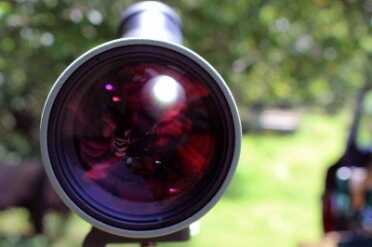
The front lens is large, and coated for maximal transmission of light. It also has a sun shield that slides out over it to prevent too much light transmission.
The last main consideration would be the ease of control. Magnification rings should move smoothly, with no hitches. Focal rings should be large, and easy to identify and find while you’re looking through the scope. The scope should mount easily to a tripod, and adjust in such a way that you can maintain sight picture while shifting magnification, focus, and angles.
On top of that, there are high tech extras. It is one thing for you to be able to see through the scope, but how easily is such information recorded, or disseminated to others?
The MeoPro 80 HD
All of the above? Check. It is one of the most effective spotting scopes I’ve used. And I’ve used it extensively. I’ve used this scope at least once a week for more than four months. You’d think I could have put together this MeoPro lovefest before now. It has become part of the kit I pack up and take with me. And after this much use, it is still holding up perfectly.
There’s a lot of science in here that I’m not sure I fully understand. I’m certainly not qualified to talk about chromatic aberation. Good glass is like that. The more research and development a company like Meopta does on their glass, the less likely we are to be aware of its importance. We simply put our eyes up and see down range. We can’t see the science, and that’s precisely the point. Look through a cheap spotting scope and you will see the lack of R&D.
Knowing how well the MeoPro works, I’ll allow Meopta to intrude with their product features.
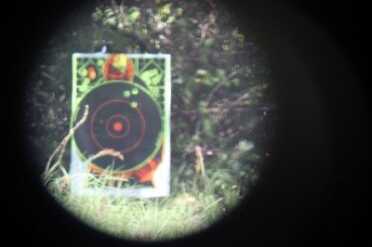
This is a hard review to document on film. The images taken through the scope aren’t indicative of the quality. This is a target seen from 100 yards. The center circle is 12″.
Features
- MeoBrightTM – A proprietary ion-assisted lens multi-coating applied to all air-to-glass optical surfaces. Developed by Meopta,
- MeoBrightTM ion– assisted multi-coatings eliminate glare and reflections and delivers an industry leading 99.8% light transmission per lens surface.
- MeoShieldTM – MeoShield TM ion-assisted coating protects external lens surfaces and delivers enhanced resistance to scratching or abrasion in extreme conditions. MeoShieldTM meets military specifications for durability and surface hardness.
- HD Lens Elements – High-definition, extra-low dispersion, fluoride objective lens elements eliminate chromatic aberration (CA) or color fringing in challenging lighting conditions and deliver pin point resolution, increased contrast and vivid color fidelity.
- CentricDriveTM – An oversized, mid-body focus control features a large rubberized wheel that is easy to manipulate for fine focus requirements or when moving rapidly from close subjects to extended distances. The CentricDriveTM is comfortable to use and easily accommodates users wearing thick gloves.
- Tripod Collar and Mount – The rotating tripod collar allows a smooth 360° degree rotation of the scope body for viewing in any orientation and locks securely in place. The low profile mounting foot directly engages Manfrotto type tripod heads and features a ¼” x 20 thread to accommodate numerous aftermarket quick release plates.
- Integrated Sun Shade – Integrated, retractable anodized aluminum sun shade keeps moisture and stray light off lenses in challenging lighting conditions. Built-in aiming element makes subject acquisition quick and easy.
- Chassis Construction – Magnesium and aluminum alloy chassis is lightweight yet extremely rugged. Beautifully sculpted rubber armor provides shock protection in the field or during transport.
- Lens Components – Individual lens components are meticulously ground and polished in-house and precisely matched for superior performance.
- Waterproof – All spotting scopes are 100% guaranteed waterproof, submersible and are fully protected against humidity, rain and snow.
- Fogproof – All spotting scopes are purged and sealed with inert Nitrogen gas to provide 100% guaranteed fogproof performance.
- Eyepiece – 20x-60x integrated variable magnification eyepiece. Multi-position twist-up eyecup accommodates all users.
- Lifetime Warranty – All spotting scopes carry Meopta’s North American Lifetime transferable Warranty.
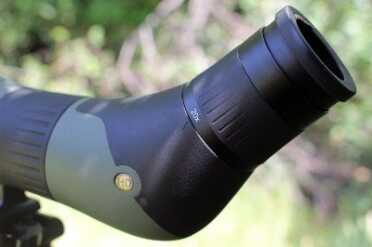
The angled eyepiece makes viewing easy. When you bend to the eyepiece, you are less likely to bump it.
How much does the MeoPro cost?
R&D is going to cost you. I’ve seen the MeoPro 80 HS on sale for $1,499. Is that too much? I don’t think so. I’m still getting accustomed to the idea of optics and scopes that cost more than the guns I shoot. But this is a sport with tiers of investment. Would I pay $3,000 for a rifle? I doubt it. I live in the south. I’m lucky if I can shoot 300 yards. And I don’t place much importance on sub-MOA performance. I respect it, but I’m not that good.
Would I pay that much for a scope? Absolutely. I have a hard time explaining this. Here’s an analogy. I just bought a ragged out 1996 Cherokee with 200K miles on it. I didn’t pay much for it. It needs new tires. I’m going to end up spending more for the tires than I did for the entire Jeep. It has tires on it that will work…for a while. For how long? When will they fail me? How can I know?
I don’t. So I’m not going to risk getting stuck way the hell out in the sticks because I saved a few bucks on tires. The same is true for glass. I may take a Ruger American rifle to the range and get sighted in for the fall hunt. But there will be good glass on top. And when I pull the trigger at a target 300 yards down range, I’ll need to see if I hit it. So I’ll be looking through the MeoPro, because that is the kind of confidence I want before I pull the trigger on a whitetail.
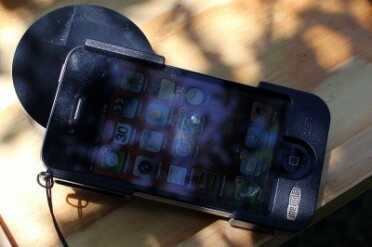
The adapter holds the phone secure. Here’s my great idea. Meopta should make an actual iPhone case, one that connects to this device. I’d leave it on my phone all the time, if I knew it would snap in place on my scope. As is, I haven’t used the iPhone adapter to its full potential.
The extras
There are a couple of other items here that are part of this equation. Meopta has an iPhone adapter that allows you to see though the phone. The MeoPix iScoping Adapter allows you to take pictures and video–essentially anything the phone can do normally. It isn’t an app, just an attachment. It works well, and is one of those cool features that I don’t really use to its full potential.
More importantly, at least for me, was the tripod. The TP-1 is all around a great match for the scope. I’d hesitate to mount something like a spotting scope on anything that could potentially bend, collapse, or fall over. This tripod is a perfect match.
[one_half]
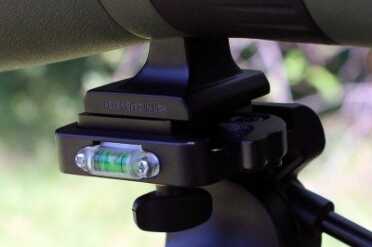
The tripod attachment snaps into place. There’s a trigger set into the mount that snaps the lever in place.
[/one_half][one_half_last]
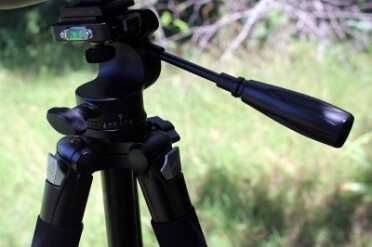
The fluid head locks into place with this lever, which controls up-down and left-right movements. Basic, sure, but the tension can be set easily, which allows you to maintain a sight picture while locking it in place.
[/one_half_last]
[one_half]
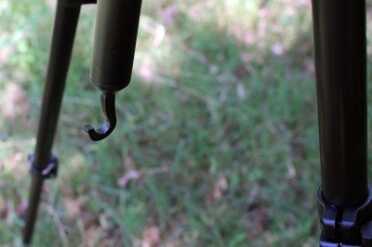
If you need more stability, the tripod has a hook that can hold weight. Or it could be used to stake down the tripod if there is heavy wind.
[/one_half][one_half_last]
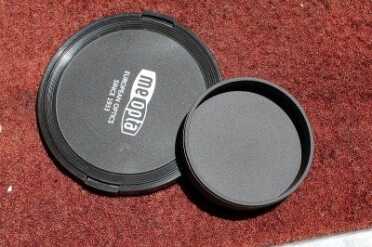
If you want to keep the glass clear and bright, protect it. This is a rugged scope that can handle abuse, but glass is glass.
[/one_half_last]
[one_half]
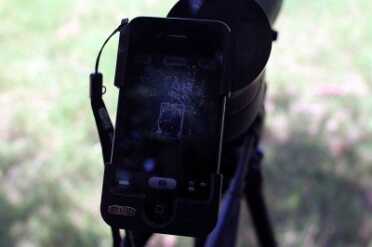
Taking a picture of an iPhone screen taking a picture through a spotting scope is actually harder than it would seem, especially in blinding sunlight.
[/one_half][one_half_last]
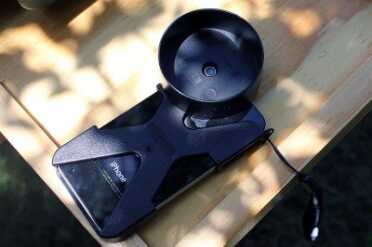
The cup on the back fits perfectly on the eyepiece of the spotting scope, unless it doesn’t. I ended up with a 49mm eyepiece, but the adapter was one size too large. It still worked well enough. I just set it on the scope and positioned it and it worked perfectly.
[/one_half_last]
[one_half]
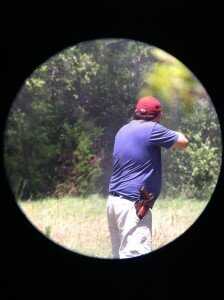
The Clarity of the Meopta is really amazing. Remember that this photo, and many of the others, are taken with an iPhone.
[/one_half][one_half_last]
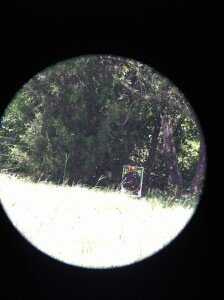
Slide out to the low end of the magnification to find targets, then lock in the tripod and begin to size up.
[/one_half_last]
[one_half]
[/one_half][one_half_last]
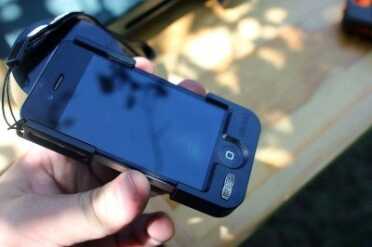
The Meopta adapter requires that you remove your phone from its protective case, but that’s the only hassle.
[/one_half_last]

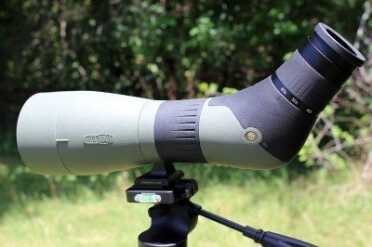
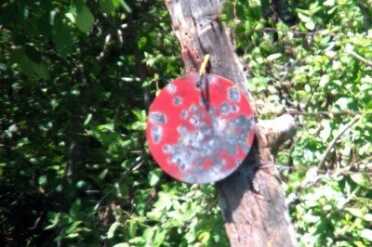
I completely agree! A good spotting scope is essential for serious shooters. It can make a significant difference in the accuracy and efficiency of your work. It’s definitely a must-have gadget for anyone who is serious about rifle shooting.
How much did you buy them for?